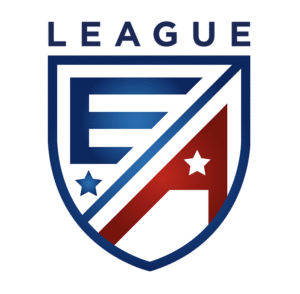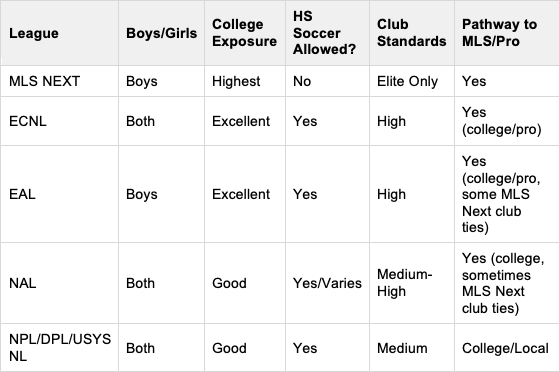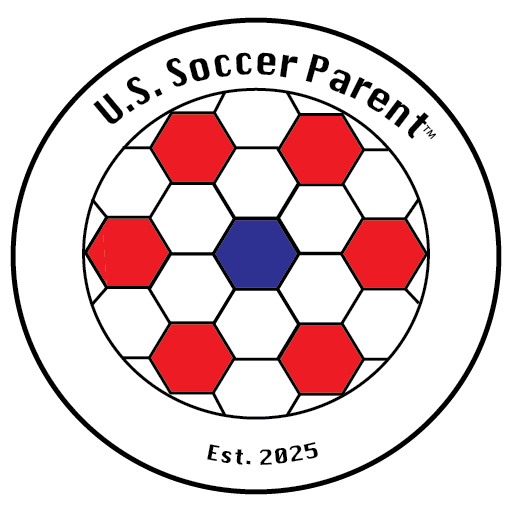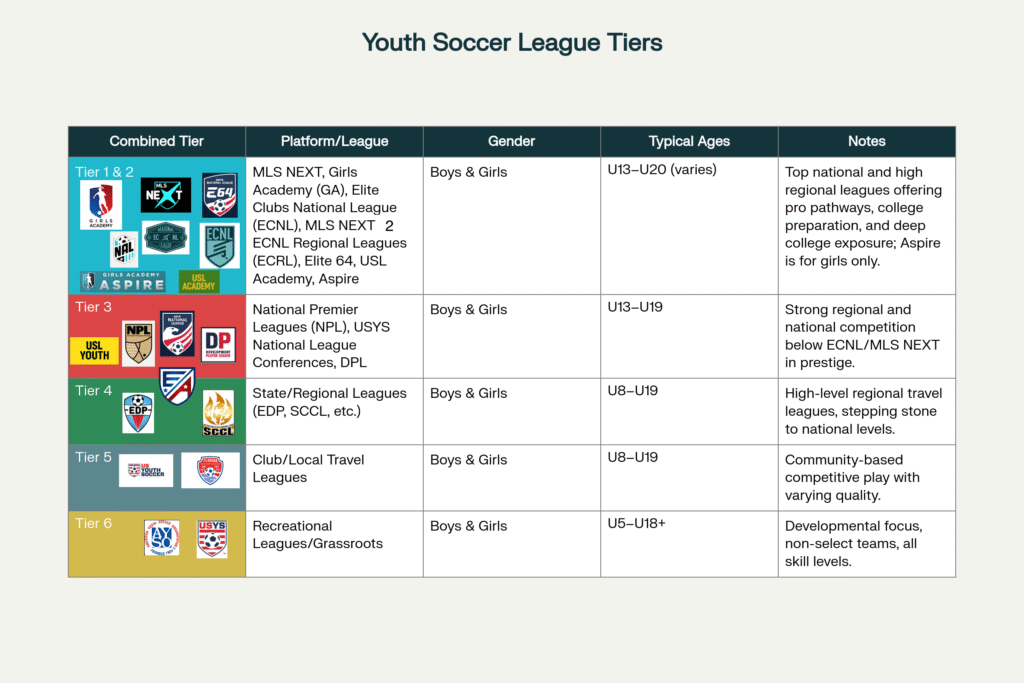The Complete Guide for Youth Soccer Parents
Navigating the world of competitive youth soccer can feel overwhelming—especially with new expansions and shifting league structures every year. For families considering the Elite Academy League (EAL) as the next step or simply wanting to understand where it fits, this detailed guide clarifies EAL’s role, benefits, and differences from other major platforms like ECNL, NAL, and MLS NEXT.

EAL in the Youth Soccer Pyramid
To understand EAL’s significance, you first need to see the big picture. The “youth soccer pyramid” in the U.S. is a layered structure that starts with recreational leagues at the base (think local AYSO and town clubs), then moves up to travel leagues and regional competitions. NOTE: There are nuances depending on regions, boys, girls, etc. Generally, at the top sit the national platforms:
- MLS NEXT: The highest boys’ youth league, run by Major League Soccer—exclusive and highly competitive, with strict development standards.
- Girls Academy (GA): Top national league for girls.
- ECNL (Elite Clubs National League): Nationally recognized for both boys and girls, providing deep competition and college recruiting exposure.
- EAL (Elite Academy League): Sits just below MLS NEXT and on par with or just under ECNL, designed to offer elite competition for clubs that extend best practices to a broader player base. Many EAL clubs also field teams in MLS NEXT, making EAL essential for extending elite opportunities to more players.
- NAL (National Academy League): Similar mission to EAL, focusing on national and regional competition, some overlap in club participation.
- NPL/DPL/USL/USYS National League: Strong regional platforms that provide additional competitive opportunities.
Key Takeaway:
For boys ages U13-U19, EAL offers one of the highest levels of competition beneath the direct MLS NEXT experience—often bridging the gap for families whose clubs have both MLS NEXT and EAL teams.
Is the EAL part of the USYS (U.S. Youth Soccer)
While the EAL is not directly part of the USYS (U.S. Youth Soccer) as a unified national league, there are important connections in certain regions:
Regional sanctioning: Some divisions of EAL, especially in the Southwest, are formally sanctioned by USYS and affiliated state bodies like Cal South, meaning the league “plays inside” the USYS framework for those areas.
Independent national platform: Nationally, EAL operates independently, aligned more closely with MLS NEXT standards and many clubs that also play in MLS NEXT. Most of its structure and standards mirror the former U.S. Soccer Development Academy rather than USYS platform rules.
Club overlap: Many EAL member clubs also field teams in USYS National Leagues (like E64) and local USYS affiliates, enabling athletes to participate in sanctioned USYS competitions outside EAL seasons.
What does this mean? The EAL is primarily an independent, elite platform, but some divisions/teams are sanctioned through USYS regionally, and clubs may compete in both systems.
For most families, EAL is considered a step above standard USYS regional leagues, modeled after pro academy development and MLS NEXT partnerships. For more specifics about your state or club, check with your local EAL club or USYS affiliate for exact sanctioning details.
What Makes EAL Different?
Developmental Philosophy
- EAL is built around the standards of the former U.S. Development Academy (DA), with additional flexibility gained from working within and alongside the MLS NEXT framework.
- Clubs joining EAL are selected for proven competitive quality, focus on development, and alignment with modern coaching and organizational standards.
- EAL clubs often have a “player-first” ethos—prioritizing individual growth, technical skill, and mental toughness.
Unique Flexibility
- High School Soccer Participation: Unlike MLS NEXT’s traditional restrictions, EAL players are allowed and even encouraged to compete for their high school teams. This gives student-athletes a balance between elite club exposure and the pride of local school representation.
- Revised Substitution Rules: Designed to maximize showcase opportunities, better utilize player pools, and help athletes be seen by college coaches.
Integrated Pathways
- EAL clubs generally also participate in MLS NEXT or have close ties to the league, giving families more options.
- Provides a structured player development pathway from foundation (U13-U15) through performance phase (U16-U19), focusing on both skill mastery and advancement to college or professional opportunities.
Showcase & Exposure Events
- EAL organizes national showcases and talent ID events attracting top college coaches and scouts—crucial for players aiming for NCAA soccer or pro ambitions.
High Standards, Broad Reach
- Member clubs are committed to coaching excellence, transparency, ethical soccer education, and long-term player support.
Highlights:
- EAL is ideal for advanced players who want exposure and development but may not have the single-minded commitment required for MLS NEXT.
- College recruiting exposure in EAL is strong—especially through national showcases and club coaching networks.
- ECNL remains more prominent for girls and has deeper established pathways, but EAL and NAL provide important alternatives for boys.

Player Pathway in the Elite Academy League (EAL & EAL 2)
U13–U15 (Foundation Phase):
- Athletes focus on mastering technical skills, building core habits, and developing a positive mindset toward growth and training.
- Players are introduced to advanced tactical concepts, with special attention to individual improvement and versatility.
- Most clubs offer both EAL and EAL 2 squads at this age, so a wide range of players get elite coaching and competitive match experience. EAL 2 teams provide additional opportunities and serve as a springboard for advancement.
U16–U19 (Performance Phase):
- The training intensity and competition level rises as players enter key recruiting years.
- Both EAL and EAL 2 teams compete in showcase events, but EAL teams often see greater exposure to college and pro scouts.
- Movement between EAL 2 and EAL squads is common—high-performing athletes may be promoted, while all players receive development aligned with national standards.
- The environment balances team success, personal progress, and individual visibility, preparing athletes for college recruiting or professional pathways.
A Typical Journey:
- Stand out at local club → Try out for EAL or EAL 2 team
- Develop within EAL or EAL 2 system (and/or HS soccer) → Attend EAL showcases, get scouted
- Advance: Progress to EAL first team, then stage into MLS NEXT, ECNL, or college/pro recruitment (sometimes residency programs)
Why EAL & EAL 2 Matter
The double-tier system gives committed, talented players more entry points and a clear, upward path—from EAL 2 to EAL, then onward to national leagues and collegiate opportunities.
The 2025/2026 Expansion is complete. To see the teams and learn about EAL & EAL 2 visit the official website HERE.
Is EAL the Right Choice for Your Family?
Only you can really answer this question. It starts with having an open, honest dialogue with your athlete first. Understand the commitment for them and your family. Seek the advice of coaches, your club and other EAL families. If your young athlete is ready for top-level competition, is looking for higher developmental pathways and also wants to participate in both elite club and high school soccer, then the EAL may be the perfect path. Its reputation for quality coaching, college exposure, and flexible pathways puts it near the top of the youth soccer pyramid for boys, offering every ambitious player (and their family) a chance to grow, compete, and shine.


